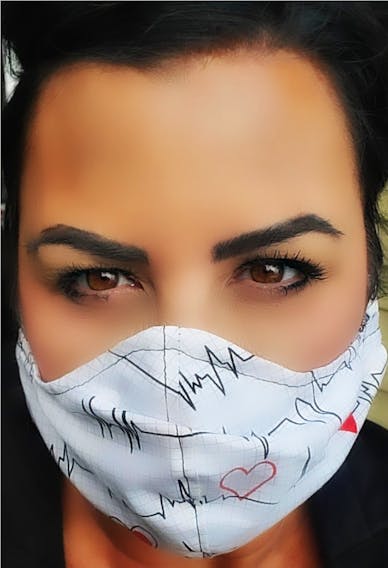With a few months of wearing face masks under our belts - or rather, on our faces – there are still plenty of questions about the best way to care for them.
Information continues to change as we learn more about COVID-19, so it’s a good idea to keep on top of current practices.
Nancy O’Halloran is the owner of Kentville, N.S. business BraveHeart First Aid, which sells first-aid equipment across Canada, including every mask available in Canada, both cloth and disposable. O’Halloran feels it’s her duty to research and obtain information from suppliers and learn as much as she can on the topic.
The best protection from COVID-19, says O’Halloran, will always be cleaning areas and hands properly and often and social distancing. She also says to treat your mask like an infected piece of equipment. Don’t put it in your pocket or lay it on the lunch table.
“You need to remember it may carry a germ you didn't know you came in contact with,” says O’Halloran.
What is the best way to wash and dry your mask?
Right now, there are so many kinds of masks and made with different types of material, including cotton, neoprene, silk, mesh, and nylon, that no one can ensure what is the proper way to wash masks, says O’Halloran.
It is actually recommended that you prepare a bleach solution and that you soak your mask in it for five minutebs prior to washing. To make this, use four teaspoons of household bleach per quart of room temperature water, says O’Halloran. Be sure to check the label to see if your bleach is intended for disinfection. Then, drain the solution and rinse the mask in cool water only.
“It is crucial that you wash the cloth masks often,” says O’Halloran.
Some studies show that viruses and bacteria can live in your masks for up to 12 hours.
Many workplaces in other countries are using slow cookers to sanitize their masks. They place a rack inside the cooker and put in three cups of distilled water. Then, place a brown bag on the rack to keep it from getting wet, and put your mask inside the bag. Set the temperature to 140 Fahrenheit (high) for 30 minutes. Then, take it out to air dry, says O’Halloran.
“It is very important that the mask is completely dried before re-wearing,” says O’Halloran.
If not, mold and mildew can grow.
Sunlight is the best way to dry masks, says O’Halloran. Some studies show that ultra-violet rays from the sun can help kill up to 99.9 per cent of pathogens. Direct sun or a hot dryer can help kill bacteria in cotton. A household dryer does not reach the temperatures required to disinfect, but it can help somewhat, she says.
What is the best way to store masks?

Store masks in a place where humans and animals aren't walking by regularly, and keep the area sanitized, says O’Halloran.
Masks should be stored in brown paper bags, plastic Ziplocs or hung in safe areas. They should never be placed on surfaces such as worktables or lunch tables.
“We have no guarantee of who is sick or carrying germs. Anyone could sneeze or breathe on your mask if you leave them in the wrong area,” explains O’Halloran.
Brown paper bags are a suggested storage system because if the mask is soiled or wet in any way, the bag helps you know whether to wash the mask or throw it out. As an added benefit, less mold and bacteria are created in paper bags than in plastic, as condensation may appear inside a plastic bag.
At home, you should hang or lay masks flat in a clean area that suits your sanitizing needs. You don’t want flies, bugs or even dust to touch it, says O’Halloran. Mildew and mold can grow in masks very easily, so it is so important that the area is dry and masks stay dry.
“Everyone will do things differently, but this is to be treated like a special piece of equipment to protect you and others,” she says.
O’Halloran keeps her mask in a brown paper bag and tries to wash her hands after touching it to get it in the bag.
Should children change their masks during the day at school?

“I believe children should have more than one mask available for the day at school,” says O’Halloran.
If your mouth isn't cleaned after you eat, especially at certain ages, you may need to change the mask. If you wore it during sweaty activities or were in an area where someone was sneezing, it should also be changed.
A child can easily dirty or soil a mask during the day by dropping it on a dirty area or floor, she points out. Everyone should have extra masks on them at all times.
One concern for children and youth is that not all families have the same privileges and family life. Some kids don’t have access to washing machines or cleaners, or don’t have parents home every evening to ensure these are clean, dried and ready for each day. Not everyone has the same consistencies, says O’Halloran.
“I wonder if perhaps we shouldn't have the schools provide seven clean masks or provide disposable masks to ensure they are actually getting cleaned,” says O’Halloran.
How should kids store their masks when not wearing them at school?

Do you remember when you taped a brown paper bag to the desk for collecting Valentines?
Everyone should have a bag taped to their desk and another on a wall somewhere with their name clearly written on it, says O’Halloran.
This is a safe way to store masks, putting them in and taking them out again by holding the ear loops.
“I like lanyards for high school, workplaces and university ages,” says O’Halloran. “For youth, it may be a choking or struggling concern.”
How should we store masks in our purses or cars?
“Storing masks is a huge concern, as we are hauling it off so fast we forget where the germs may be as well as the germs on our face. We throw masks on seats, tables and hang them from car mirrors etc. This is not sanitary,” warns O’Halloran.
Instead, O’Halloran suggests having a paper bag clipped to your dashboard on the passenger seat.
It is important to focus on using the ear loops for removing and retrieving the mask.
How do you know when a mask fits you?
Because everyone’s face, nose and ears are so unique, no two people will likely use the same masks, explains O’Halloran.
“You know it fits when you breathe in and out and you feel comfortable with the space between the material and your mouth. Make sure it touches the bridge on your nose and the tip of your chin,” she says.
Check to see if there is too much pressure on your nose and if the ear loops suit your ears. It should feel natural on your ears, like wearing glasses.
“You may be sore at first, but it should go away with practice wear time,” says O’Halloran. “You'll learn which ones best suit you and your needs over time.”
You want the mask to fit snugly and for there to be no gaps on the sides.
Should masks with valves be avoided?
Masks with valves do not protect others from COVID-19, explains O’Halloran. Some towns and countries have even banned masks with exhaust valves.
The intent of this style was to be more comfortable for the wearer, but it also allows infectious droplets to be released outside the mask. This does not protect anyone in your close area.
The valve opens to allow your exhaled air to escape to prevent heat buildup in your mask. It’s great for using in construction to protect you from inhaling dust, but not so great when you are dealing with a world pandemic, she says.









